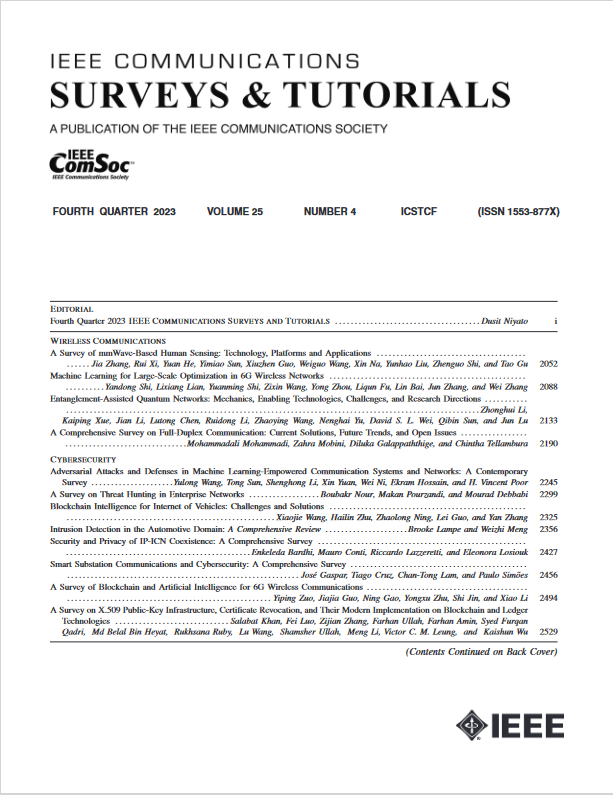Quantum Computing in Wireless Communications and Networking: A Tutorial-cum-Survey
IF 34.4
1区 计算机科学
Q1 COMPUTER SCIENCE, INFORMATION SYSTEMS
引用次数: 0
Abstract
Owing to its outstanding parallel computing capabilities, quantum computing (QC) has been a subject of continuous attention. With the gradual maturation of QC platforms, it has increasingly played a significant role in various fields such as transportation, pharmaceuticals, and industrial manufacturing, achieving unprecedented milestones. In modern society, wireless communication stands as an indispensable infrastructure, with its essence lying in optimization. Although artificial intelligence (AI) algorithms such as reinforcement learning (RL) and mathematical optimization have greatly enhanced the performance of wireless communication, the rapid attainment of optimal solutions for wireless communication problems remains an unresolved challenge. QC, however, presents a new alternative. This paper aims to elucidate the fundamentals of QC and explore its applications in wireless communications and networking. First, we provide a tutorial on QC, covering its basics, characteristics, and popular QC algorithms. Next, we introduce the applications of QC in communications and networking, followed by its applications in miscellaneous areas such as security and privacy, localization and tracking, and video streaming. Finally, we discuss remaining open issues before concluding.无线通信和网络中的量子计算:教程与调查
量子计算由于其出色的并行计算能力,一直受到人们的关注。随着QC平台的逐步成熟,它在交通运输、制药、工业制造等各个领域发挥着越来越重要的作用,取得了前所未有的里程碑。在现代社会中,无线通信是必不可少的基础设施,其本质在于优化。尽管诸如强化学习(RL)和数学优化等人工智能(AI)算法极大地提高了无线通信的性能,但快速获得无线通信问题的最优解仍然是一个未解决的挑战。然而,QC提出了一种新的选择。本文旨在阐述QC的基本原理,并探讨其在无线通信和网络中的应用。首先,我们提供了一个关于QC的教程,涵盖了它的基础知识、特点和流行的QC算法。接下来,我们将介绍QC在通信和网络中的应用,然后介绍其在安全和隐私、本地化和跟踪以及视频流等其他领域的应用。最后,在结束之前,我们讨论了一些悬而未决的问题。
本文章由计算机程序翻译,如有差异,请以英文原文为准。
求助全文
约1分钟内获得全文
求助全文
来源期刊

IEEE Communications Surveys and Tutorials
COMPUTER SCIENCE, INFORMATION SYSTEMS-TELECOMMUNICATIONS
CiteScore
80.20
自引率
2.50%
发文量
84
审稿时长
6 months
期刊介绍:
IEEE Communications Surveys & Tutorials is an online journal published by the IEEE Communications Society for tutorials and surveys covering all aspects of the communications field. Telecommunications technology is progressing at a rapid pace, and the IEEE Communications Society is committed to providing researchers and other professionals the information and tools to stay abreast. IEEE Communications Surveys and Tutorials focuses on integrating and adding understanding to the existing literature on communications, putting results in context. Whether searching for in-depth information about a familiar area or an introduction into a new area, IEEE Communications Surveys & Tutorials aims to be the premier source of peer-reviewed, comprehensive tutorials and surveys, and pointers to further sources. IEEE Communications Surveys & Tutorials publishes only articles exclusively written for IEEE Communications Surveys & Tutorials and go through a rigorous review process before their publication in the quarterly issues.
A tutorial article in the IEEE Communications Surveys & Tutorials should be designed to help the reader to become familiar with and learn something specific about a chosen topic. In contrast, the term survey, as applied here, is defined to mean a survey of the literature. A survey article in IEEE Communications Surveys & Tutorials should provide a comprehensive review of developments in a selected area, covering its development from its inception to its current state and beyond, and illustrating its development through liberal citations from the literature. Both tutorials and surveys should be tutorial in nature and should be written in a style comprehensible to readers outside the specialty of the article.
 求助内容:
求助内容: 应助结果提醒方式:
应助结果提醒方式:


